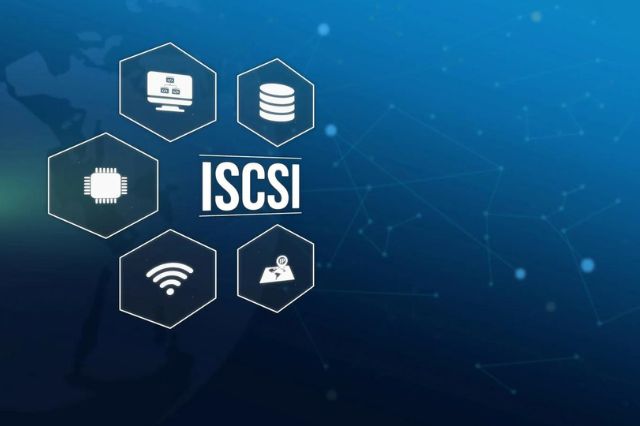iSCSI: Understanding Its Core Principles and Usage

In the rapidly developing area of data processing, storage decisions’ quality and speed are significant factors. One of the primary technologies employed in network storage is an Internet Small Computer Systems Interface (iSCSI). The following article discusses the core concepts of iSCSI, structure, advantages, and possible applications to grasp the reasons for its wide use.
What Is iSCSI?
iSCSI is a network protocol that enables the transfer of SCSI commands across IP networks. It represents an alternative to storage area networks that leverage existing network infrastructure, ensuring a lower price tag than conventional SAN systems like Fibre Channel.
Key Components of iSCSI
The critical components of iSCSI include:
- Initiator: The iSCSI initiator is the client side of traffic responsible for sending SCSI commands to the storage device. It implements the software-based iSCSI protocol that runs on the host system. Alternatively, there are the host bus adapters that run a dedicated hardware network interface card with built-in iSCSI capabilities.
- Target: The iSCSI target is the server-side system that executes SCSI commands traded with the initiator. The target is usually a storage device, such as a disk array or a storage server, but the concept may also refer to a separate software service.
- iSCSI Qualified Name (IQN): iSCSI systems are defined by IQNs, which are alphanumeric identifiers instead of devices. IQNs execute the same function as MAC addresses in networking to ensure the conveyed data arrives at the destination device.
How iSCSI Works
The iSCSI format packets SCSI commands held for the majority of years to be exclusively transmitted over SCSI wires, usually to tape devices but sometimes to hard disks. iSCSI works by implementing the SCSI to the Ethernet network. iSCSI works in the following way:
- Initiation: The iSCSI initiator connects with the iSCSI target using the TCP/IP protocol.
- Authentication: Authentication mechanisms, such as CHAP (Challenge Handshake Authentication Protocol), ensure secure connections.
- Command Transmission: SCSI commands are encapsulated into iSCSI packets and then sent over the IP network to the target.
- Execution: The process begins with the target decapsulating the iSCSI packets, after which it extracts the SCSI commands and executes them on the storage device.
- Response: The target then encapsulates the information in the response into the iSCSI packets and sends them back to the initiator.
Benefits of iSCSI
Several advantages make iSCSI an excellent choice for networked storage solutions. They include the following:
Cost-Effectiveness
iSCSI is inexpensive for SANs, whereas Fiber Channel SANs are more expensive to install and operate because they rely on unique hardware and cables. iSCSI may also be sent using the current Ethernet systems, eliminating any need for new equipment.
Scalability
This solution can scale to businesses of any size without updating or replacing their existing systems.
Simplicity and Compatibility
Since it uses the Ethernet and IP network, iscsi is more straightforward to set up and use. IT users can easily set it up with minimal similarity. Additionally, it uses existing networking protocols and equipment.
Performance
Fiber Channel is often considered a better choice, but the advancement of the Ethernet network has closed the gap. For example, 10 Gigabit Ethernet allows businesses to use more than one band.
Use Cases for iSCSI
iSCSI is versatile and can be used in various scenarios requiring networked storage. Here are some everyday use cases:
Virtualization
ISCSI is famous for connecting virtual machines (VMs) to centralized storage in virtualized environments. Creating flexible and easily manageable storage pools is crucial in virtualization, and iSCSI efficiently delivers this capability.
Backup and Disaster Recovery
One of iSCSI’s everyday use cases is backup and disaster recovery solutions. Its capability to send data over long distances using ordinary IP networks allows businesses to replicate data to offsite areas during a catastrophe.
Database Storage
Databases need rapid and reliable storage solutions, and iSCSI provides the required speed. Therefore, its viability for database applications cannot be questioned. In addition, it is compatible with various operational systems and database administration systems.
Remote Offices and Branches
In light of the above information, businesses with subordinate offices can leverage iSCSI as a centralized storage solution that can be managed centrally in case of storage failures. This minimizes the need for on-site IT staff and simplifies data management across economies.
Implementing iSCSI
Implementing iSCSI involves setting up and configuring ISCSI disk devices on both iSCSI initiators, commonly known as clients and iSCSI targets, widely referred to as servers. Below is a high-level step-by-step process for iSCSI implementation:
Hardware and Software Requirements
To implement an iSCSI SAN, the following hardware and software are necessary:
- iSCSI Initiators: They can originate either as server-based initiators or hardware-based iSCSI Host Bus Adapters.
- iSCSI Targets: These are storage devices or servers engineered to act as iSCSI targets.
- Networking Equipment: Ethernet switches and cables. Consider utilizing dedicated storage networks or VLANs to isolate iSCSI traffic for high efficiency.
- Management Software: Implementation software is used to configure and control iSCSI connections, typically provided by a storage authority.
Configuration Steps
- Install and Configure iSCSI Initiators: This entails installing the software or hardware iSCSI initiator on the client systems.
- Set Up iSCSI Targets: Configure the storage devices to act as iSCSI targets. This involves setting up LUNs (Logical Unit Numbers) and defining access controls.
- Establish Connections: Use the initiator software to discover and connect to the iSCSI targets using their IQNs.
- Authenticate Connections: Consider authenticating connections using techniques such as CHAP.
- Map Storage: Map the LUNs on the iSCSI targets to the iSCSI initiators created above to make the storage available to the client systems.
Best Practices
- Network Segmentation: Separate iSCSI traffic from the regular network to avoid congestion and ensure the best performance. This can be achieved using VLANs or dedicated storage networks to isolate the flow of iSCSI.
- Performance Tuning: Tweaking network and storage settings can enhance iSCSI performance. This may include updating the MTU size to use jumbo frames, enabling the jumbo frame, etc. You can also use a quality of service policy to allocate bandwidth between different traffic types.
- Monitoring and Management: You must use monitoring tools to monitor performance and proactively detect any issues relating to iSCSI. It would help to look at logs for unexpected behavior and performance metrics continually.
- Security: Take defensive and offensive security mechanisms to ensure that data transferred over the iSCSI network is confidential.
Conclusion
iSCSI represents a cost-effective and reliable network storage method with numerous benefits, such as scalability, simplicity, and compatibility. This technology is intended to use current Ethernet resources, so it is an excellent choice for businesses seeking to promote their storage area networks.
By focusing on iSCSI’s core principles and best practices, organizations can set up and manage iSCSI solutions to meet changing storage requirements.
As technology improves, iSCSI’s application in network storage is expected to expand because of its adaptability and future enhancements to Ethernet performance. With iSCSI as the foundation for storage, businesses can be assured that they will meet their various virtualization, backup, database storage, and remote office connection data management needs.




